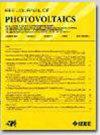Pseudorandom Sequence Coded Electroluminescence Imaging for Photovoltaic Module Inspection Under Strong Environmental Light
IF 2.5
3区 工程技术
Q3 ENERGY & FUELS
引用次数: 0
Abstract
The inspection for photovoltaic (PV) module is mainly used in darkroom based on electroluminescence (EL) imaging. To improve the universality and anti-interference characteristic, this aricle proposes a pseudorandom-sequence coded EL (PRC-EL) for PV module inspection under ambient light. In the proposed method, the uncorrelated ambient light is inhibited by an equilibrium sequence, which results in a much higher anti-noise performance for PV inspection. The feasibility of the proposed PRC-EL method is verified mathematically and a prototype system is established in this work. The experimental results show that this method can significantly improve the anti-interference ability of EL detection method. The EL image can be recovered by using a 10 bit industrial camera for outdoor measurements (the peak is 286强环境光下光伏组件检测的伪随机序列编码电致发光成像
基于电致发光成像的光伏组件检测主要是在暗室中进行的。为了提高环境光下光伏组件检测的通用性和抗干扰性,本文提出了一种伪随机序列编码EL (PRC-EL)。在该方法中,不相关的环境光被平衡序列抑制,从而提高了光伏检测的抗噪性能。本文从数学上验证了PRC-EL方法的可行性,并建立了原型系统。实验结果表明,该方法能显著提高EL检测方法的抗干扰能力。使用10位工业相机进行室外测量可以恢复EL图像(峰值为286 $\rm {W}/\rm {m}^{2}$), 40.8 $\rm {W}/\rm {m}^{2}$可以被低成本的8位相机容忍,适用于室内和多云环境。此外,在大范围变化的环境光照条件下,自适应PRC-EL方法可以连续恢复稳定的高质量图像。该方法可以充分利用日常工作时间和工作条件对光伏组件进行无损检测和在线检测,大大扩展了光电检测方法的潜在应用场景。所提出的方法显示了在详细的定期检查、分类和光伏组件性能研究方面提供改进的主要潜力。
本文章由计算机程序翻译,如有差异,请以英文原文为准。
求助全文
约1分钟内获得全文
求助全文
来源期刊

IEEE Journal of Photovoltaics
ENERGY & FUELS-MATERIALS SCIENCE, MULTIDISCIPLINARY
CiteScore
7.00
自引率
10.00%
发文量
206
期刊介绍:
The IEEE Journal of Photovoltaics is a peer-reviewed, archival publication reporting original and significant research results that advance the field of photovoltaics (PV). The PV field is diverse in its science base ranging from semiconductor and PV device physics to optics and the materials sciences. The journal publishes articles that connect this science base to PV science and technology. The intent is to publish original research results that are of primary interest to the photovoltaic specialist. The scope of the IEEE J. Photovoltaics incorporates: fundamentals and new concepts of PV conversion, including those based on nanostructured materials, low-dimensional physics, multiple charge generation, up/down converters, thermophotovoltaics, hot-carrier effects, plasmonics, metamorphic materials, luminescent concentrators, and rectennas; Si-based PV, including new cell designs, crystalline and non-crystalline Si, passivation, characterization and Si crystal growth; polycrystalline, amorphous and crystalline thin-film solar cell materials, including PV structures and solar cells based on II-VI, chalcopyrite, Si and other thin film absorbers; III-V PV materials, heterostructures, multijunction devices and concentrator PV; optics for light trapping, reflection control and concentration; organic PV including polymer, hybrid and dye sensitized solar cells; space PV including cell materials and PV devices, defects and reliability, environmental effects and protective materials; PV modeling and characterization methods; and other aspects of PV, including modules, power conditioning, inverters, balance-of-systems components, monitoring, analyses and simulations, and supporting PV module standards and measurements. Tutorial and review papers on these subjects are also published and occasionally special issues are published to treat particular areas in more depth and breadth.
 求助内容:
求助内容: 应助结果提醒方式:
应助结果提醒方式:


